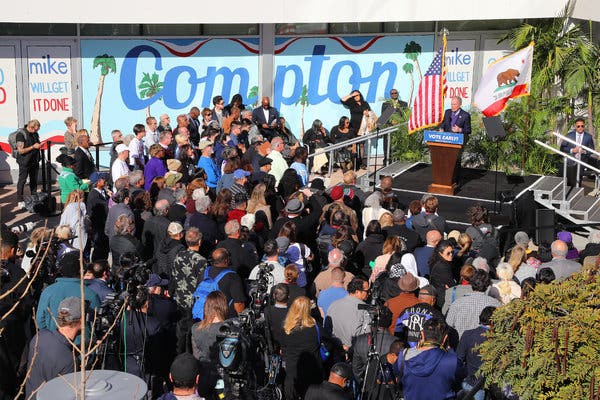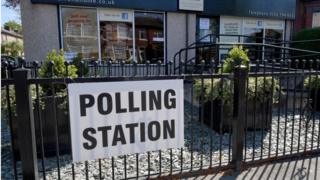Advertisement
And Michael Bloomberg and Bernie Sanders are competing fiercely in places like Fresno, where candidates very rarely go.

FRESNO, Calif. — “There’s nothing magical about California,” Michael R. Bloomberg declared after a day flying through the state — or Iowa, for that matter, he added.
But here he was in California, not any of the four early nominating states, trying to make the magic happen.
So there were free carne asada tacos in front of Fresno City College, along with free Mike 2020 T-shirts, designed to draw a lunchtime crowd to hear the former New York mayor speak in a courtyard lined with citrus trees.
“I have never backed down from a bully or run away from a fight,” Mr. Bloomberg said, standing in front of dozens of signs urging supporters to “vote early.” Then he turned to the core of his appeal: “I’m the un-Trump.”
It is simple math — with 415 delegates, California has more electoral power than all four early states combined. And while the political world waited for, then pored over, the partial results from not quite 170,000 voters in Iowa, there are currently about 20 million registered voters in California, and roughly 15 million of them received mail-in ballots this week.
Typically a late-spring afterthought in the nominating contests, and largely ignored in the general election because their state is so reliably blue, the voters of California aren’t accustomed to culling national candidates.
But this year, state officials moved voting day to Super Tuesday, the earliest the California primary has been since 2008.
California matters now. And the earlier primary means that presidential candidates are spending time and money in parts of the state that rarely see big-name politicians of any kind. Democratic Senate candidates and would-be governors often skip over the Central Valley, the agricultural heart of California, reasoning there are far more votes to be had outside the relatively rural and conservative part of the state.
“The Appalachia of California,” is how Antonio Villaraigosa, the former mayor of Los Angeles, referred to the Central Valley as he traveled with Mr. Bloomberg Monday in Fresno, the region’s largest city by population, after offering his endorsement and becoming a national political co-chair for the campaign.
While the coastal cities of Los Angeles and San Francisco have long been treated as political ATMs, the less wealthy Central Valley and Inland Empire have often struggled for attention and power.
But now California’s Inland Empire, as the region about 50 miles east of Los Angeles is known, is a must-stop. Senator Bernie Sanders and Mr. Bloomberg, the candidates who have devoted the most resources to California, have both come to campaign in person and opened up field offices in the area, as well as in the Central Valley.
“People here have been beaten down for so long that they feel like their vote doesn’t matter,” said Michael Gomez Daly, the executive director for Inland Empire United, a left-leaning political advocacy group.
Smaller communities in other parts of the country have gotten attention from politicians for years, he said. “Now it’s our turn to say: ‘These are the issues and what are you going to do about it?’”
Like many other local leaders, Mr. Gomez Daly lists homelessness, poverty, immigration and the environment as some of the most pressing concerns for the region. In an area packed with warehouses used to distribute imported goods all over the country, activists in the region have been focusing their ire on Amazon, blaming the behemoth for stagnant low wages and pollution.
When Mr. Sanders visited, he too spoke out against Amazon by pitching the Green New Deal, which would crack down on truck emissions that pollute the region.
Just as in other Super Tuesday states, Michael Bloomberg is spending lavishly to get on the airwaves here — so far paying nearly $34 million to advertise on television across the state, including roughly $1.8 million on Spanish-language stations, according to Advertising Analytics.
His money is by far eclipsing other candidates who remain focused elsewhere. Only the other billionaire in the race, Tom Steyer, has come anywhere close, spending nearly $15 million since last summer. Mr. Sanders’s campaign has spent roughly $3 million on television in California so far, and has said it plans to spend over $2.5 million more, spread between California and Texas, another delegate-rich Super Tuesday state. (None of the other top candidates have advertised on television so far.)
But the attention goes beyond the airwaves. The Sanders and Bloomberg campaigns are testing the theory that California is not a place that can be organized with foot soldiers.
So far, Mr. Bloomberg has 220 staff members throughout the state, a number his campaign expects to grow to 800 by the end of the month. Mr. Sanders’s campaign, which has operated several offices throughout the state, has about 90 organizers.
Though longtime political operatives in the state dismiss the notion that reaching out to individual voters is effective in a statewide election, the Sanders campaign boasts of knocking on 400,000 doors and making 3.5 million phone calls in California in the last year.
Both the Sanders and Bloomberg campaigns are specifically targeting the Inland Empire and Central Valley, two of the only regions in the state that still send Republicans to Congress. While Mr. Bloomberg’s supporters believe he can attract moderate voters from the area, Mr. Sanders’s staff is focusing on voters who backed Barack Obama and then switched to Donald J. Trump in those regions — especially white working-class men.
“Riverside is our Des Moines,” said Anna Bahr, a California spokeswoman for the Sanders campaign, describing efforts in the Inland Empire city.
Other campaigns seem to be taking a more traditional approach, waiting for more results to shake out in the early states before pouring money into California.
Senator Elizabeth Warren has held several large rallies in the state, but so far has a smaller staff operation. Advisers to former Vice President Joseph R. Biden Jr. say that their internal polling shows that he consistently meets the 15 percent threshold — the number needed to secure delegates — in each of the state’s congressional districts.
Current polling shows Mr. Sanders leading, ahead of Mr. Biden and Ms. Warren. Both Pete Buttigieg, the former mayor of South Bend, Ind., and Mr. Bloomberg have yet to break into the top tier in the state.
A candidate needs to capture at least 15 percent of the vote in a congressional district or statewide in order to win delegates in California. Because the state has such a large number of delegates, it is possible for a candidate to rack up many delegates toward the nomination, even if he or she does not win the popular vote here. And if the race is tight, it is possible it will take days or weeks before the final results are clear.
Mr. Bloomberg, thanks to his resources, remains the biggest unknown factor. Campaign officials say they are confident they have more time to ramp up, with many voters still undecided and Mr. Biden’s top-tier standing in question after a weak performance in the Iowa caucuses.
Jerry Brown, the former governor who remains one of the state’s most popular political figures, said he believes the Democratic nomination may not be decided until the summer convention, but that Mr. Bloomberg could easily shift the dynamics with his spending alone. Though California has a history of rejecting self-funded candidates, Mr. Brown recalled watching his own internal polls steadily tick up during his 2010 race for governor, as he began spending heavily on television ads.
“I had been behind from May to September, then we started on television after Labor Day and I started going up a point or two every week,” he said. “California voters are swayed by what they see on their televisions.
At his rallies across the state Monday, several people in the crowds said they remained undecided, but were considering Mr. Bloomberg in part because of his willingness to spend lavishly to beat Mr. Trump and his experience in running the largest city in the country.
Still, there were signs of Mr. Bloomberg’s uphill battle, particularly among people of color, several of whom mentioned the stop-and-frisk policing tactic that he pursued for a decade and that disproportionately targeted black and Latino men. Mr. Bloomberg defended the policy for years before apologizing late last year.
“We’ve heard a lot of candidates make a lot of promises to the African-American community and then no follow through,” said Nina Childs, 36, a writer who lives in Compton. “A lot of people I know, a lot of black millennials are really excited by Sanders. Are they going to get excited by someone who supported stop and frisk, like Bloomberg? No.”
Latinos make up roughly 24 percent of likely voters in California, and the Sanders campaign has made getting their votes a cornerstone of its strategy here.
So far, Mr. Sanders’s campaign has spent roughly $1.7 million on Spanish-language television advertising, according to Advertising Analytics, about the same as Mr. Bloomberg. And Mr. Bloomberg is aggressively courting moderate Latino and black voters, touting the backing of Mr. Villaraigosa and Aja Brown, the mayor of Compton and one of several African-American leaders to endorse him in recent days.
“Central Valley issues are Latino issues, and Latino issues are American issues,” Mr. Bloomberg told voters in Fresno.
Mr. Bloomberg, who is known for his earnest but halting attempts to speak Spanish, shied away from speaking the language on the stump through his tour of the state. Then, in Compton, he riffed on the Super Bowl halftime show.
“I think we know which team put on the most impressive performance,” he said. “Shar-eek-ah and JLo.” The crowd laughed politely, seemingly forgiving the mangled pronunciation of the Colombian superstar Shakira’s name.
In some ways, the campaigns’ California plans seem to echo the “fishhook strategy” Republicans tried to use in the state decades ago, targeting the central region of the state and inland Southern California, said Karthick Ramakrishnan, a professor of public policy and politics at the University of California, Riverside.
“I think this region is getting to a stage where people here expect to be treated better, in terms of having candidates actually visit and paying attention to them,” Mr. Ramakrishnan said.
Rusty Bailey, the mayor of Riverside, describes himself as a moderate and is registered as “no party preference” but plans to vote in the Democratic primary. He was leaning toward Mr. Buttigieg until Mr. Bloomberg came to stump in Riverside in January.
The top issue in the region is homelessness, Mr. Bailey said, and he believes that Mr. Bloomberg understands the concerns.
Mr. Gomez Daly, the policy director of the Inland Empire advocacy group, said that the infusion of attention was a “dream for the local political infrastructure.”
And, he said, he sees other benefits too.
“Everybody I know seems to have been hired by the Sanders and Bloomberg campaigns.”
-
- On a private conference call, Iowa Democratic leaders revealed more about how the results reporting process went calamitously awry.
- After each suffering a damaging setback in Iowa, Joe Biden and Elizabeth Warren are pursuing very different strategies to seek a revival.
-
- Iowa Democratic officials say a delay in results is largely because of a “quality control” effort. As results become available, we’ll post them here.
-
- Learn more about the top-polling Democratic presidential contenders.
-


